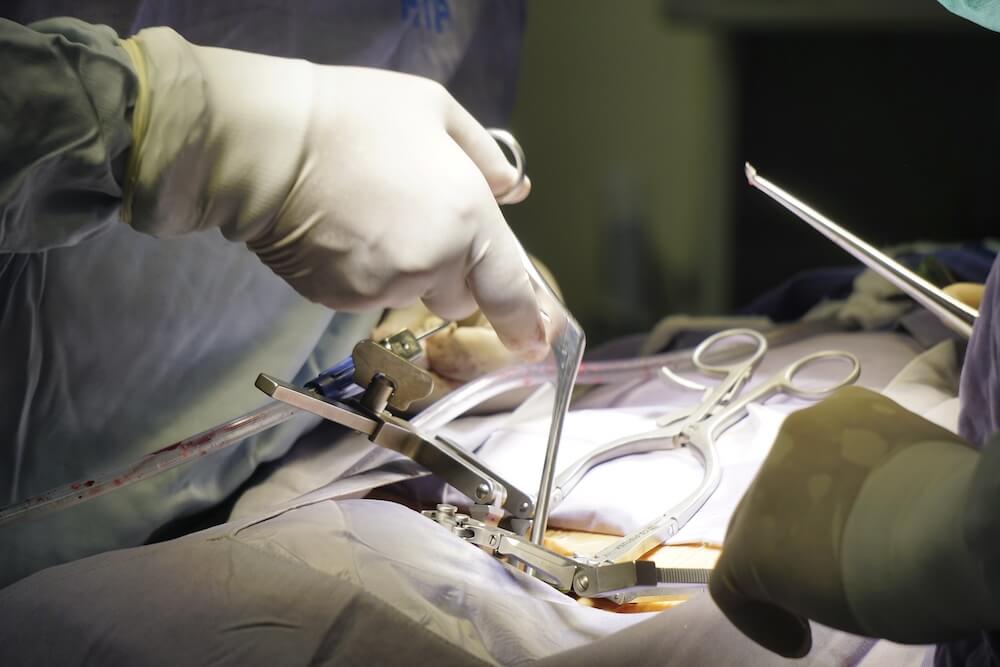Innovations in Minimally Invasive Spine Surgery: Less Pain, Faster Recovery Time
Minimally invasive spine surgery (MISS) is transforming the landscape of spinal treatments. By utilizing advanced techniques and cutting-edge technology, MISS offers patients a less painful, faster path to recovery.

Spinal issues such as degenerative disc disease or back pain affects millions of people today, with sedentary lifestyles only adding to the rising prevalence of these problems.
MISS is more than a surgical procedure; it represents the culmination of decades of medical research and innovation. As an expert neurosurgeon, Dr Baker is a big proponent and pioneer of robotic spine surgery and an expert in minimally invasive spine surgery.
Early approaches to spine surgery involved open procedures, often requiring long incisions and extensive tissue disruption. However, research has shown that these traditional methods came with significant drawbacks.
Further Reading & research
Patients often faced a prolonged recovery period, substantial post-operative pain, and noticeable scarring due to long incisions.
In recent years, innovations in surgical techniques and technology have led to the development of MISS.
The transition from open surgery to minimally invasive procedures has revolutionized the field, offering numerous advantages.
Published medical research and studies have consistently demonstrated the superiority of MISS in terms of reduced post-operative pain, faster recovery, smaller incisions, and cosmetic benefits.
Understanding the Basics of Minimally Invasive Surgery
To truly grasp the significance of minimally invasive spine surgery (MISS), it's essential to start with the fundamentals. But what exactly is MISS, and why has it become a cornerstone in spinal healthcare?
What is MISS?
Minimally invasive spine surgery refers to a collection of surgical techniques designed to treat spinal disorders with minimal disruption to surrounding tissues.

This approach significantly differs from traditional open surgery, which often involves long incisions, extensive muscle dissection, and prolonged recovery periods.
Instead, MISS relies on small incisions and specialized instruments that allow surgeons to access the spine with precision.
When Did Minimally Invasive Spine Surgery Develop?
The roots of MISS can be traced back to the late 20th century when medical professionals began exploring alternatives to open spinal surgery.
These traditional procedures often caused considerable trauma to the patient's body, leading to longer hospital stays and increased post-operative pain.
Recognizing the need for improvement, medical researchers embarked on a journey to refine spinal surgery techniques.
The Rise of Spine Issues
The prevalence of spinal issues is on the rise, largely due to modern sedentary lifestyles. Long hours spent hunched over desks or screens can take a toll on the spine, leading to conditions like herniated discs, spinal stenosis, and degenerative disc disease.
MISS emerges as a solution precisely because it addresses these issues while minimizing the harm to patients.

Medical research and studies have been instrumental in advancing our understanding of spinal conditions and the need for less invasive procedures. They've shown that MISS significantly reduces recovery time, post-operative pain, and the risk of complications, all while offering better cosmetic results through smaller incisions.
The Evolution of Spine Surgery

Understanding how spine surgery has evolved over the years is crucial to appreciating the significance of minimally invasive spine surgery (MISS).
Traditional spine surgeries, while valuable, have limitations that have driven the development of more advanced techniques.
Medical research and studies have been instrumental in advancing our understanding of spinal conditions and the need for less invasive procedures.
They've shown that MISS significantly reduces recovery time, post-operative pain, and the risk of complications, all while offering better cosmetic results through smaller incisions.
Advancements in Surgical Techniques
The history of spine surgery is marked by innovation. Over the years, surgeons have devised various techniques to address spinal disorders. Early methods, while groundbreaking in their time, often required extensive muscle dissection and long incisions. These approaches had significant drawbacks, including longer hospital stays and increased post-operative pain.
Medical professionals recognized the need for less invasive procedures that could offer patients a better quality of life. This realization sparked a wave of advancements in surgical techniques.
Traditional vs. Minimally Invasive Spine Surgery
To appreciate the full extent of MISS's benefits, it's crucial to highlight the key differences between traditional open spine surgery and minimally invasive procedures.

Traditional open surgery typically involves long incisions and extensive muscle dissection, leading to more substantial damage to surrounding tissues.
This results in a longer recovery process, increased post-operative pain, and a higher risk of complications.
In contrast, MISS relies on smaller incisions, often less than an inch in size, and specialized instruments that allow surgeons to access the spine with precision.
This minimizes harm to surrounding tissues, leading to reduced post-operative pain and a shorter recovery period. Smaller incisions also offer cosmetic benefits, leaving patients with less noticeable scars.
Less Anesthesia Complications
Minimally Invasive Spine Surgery (MISS) can reduce the need for general anesthesia, offering benefits such as lower risks of anesthesia-related complications, quicker recovery from anesthesia, reduced respiratory concerns, shorter hospital stays, enhanced postoperative pain management, and improved patient satisfaction.
By using localized anesthesia techniques, MISS minimizes the patient's reliance on general anesthesia, mitigating risks associated with it and enabling patients to wake up faster and recover more comfortably. This approach contributes to shorter hospitalization, better pain control, and increased patient contentment, ultimately enhancing the overall surgical experience and outcomes.
Benefits of Minimally Invasive Spine Surgery
Reduced Pain and Discomfort
One of the most compelling benefits of minimally invasive spine surgery (MISS) is the significant reduction in post-operative pain and discomfort. This improvement in patient comfort is not anecdotal but rather grounded in scientific research and medical studies.
In traditional open spine surgery, the extensive muscle dissection and long incisions required often lead to more substantial damage to surrounding tissues.
This results in heightened post-operative pain and discomfort for patients. However, MISS employs a fundamentally different approach.
Scientific studies consistently show that smaller incisions, a hallmark of MISS, lead to less harm to surrounding tissues. These smaller incisions cause less trauma, resulting in reduced post-operative pain. Patients who undergo MISS typically require less pain medication, promoting a faster and more comfortable recovery.
Faster Recovery
One of the most compelling benefits of Minimally Invasive Spine Surgery (MISS) is the remarkably shorter recovery times it offers, which is supported by concrete medical evidence.
In traditional open surgery, the extensive muscle dissection and larger incisions necessitate a more extended hospital stay and a more protracted recovery process. Research studies and scientific literature underscore these differences, emphasizing the advantages of MISS.
Several medical studies, including research published in reputable journals like the Journal of Spine Surgery have consistently shown that MISS, with its smaller incisions, leads to significantly faster recovery times compared to traditional open surgery.
Patients who undergo MISS experience quicker postoperative rehabilitation and can typically return to their normal activities sooner.

Implications for Physical Therapy
Additionally, physical therapy, a crucial component of postoperative recovery, is facilitated by MISS. Due to the reduced trauma to surrounding tissues, patients often find physical therapy more manageable and less painful after minimally invasive procedures.
This integration of MISS and physical therapy not only expedites recovery but also enhances the overall patient experience.
Smaller Incisions for Cosmetic Benefits and Reduced Infection Risk
The cosmetic benefits of MISS cannot be understated. Smaller incisions result in less noticeable scars, a factor that can significantly impact a patient's satisfaction with their surgical outcome. This aesthetic advantage is supported by scientific research, highlighting the cosmetic results of MISS.
Moreover, the reduced risk of infection due to smaller incisions is well-documented in medical literature. Smaller incisions lead to fewer complications and a lower risk of infection, as supported by various scientific studies.
These benefits underscore the transformative nature of MISS and emphasize why it has become a preferred choice for many patients seeking relief from spine conditions.
The Role of Technology
Introduction to Technology in Spine Surgery
In the realm of minimally invasive spine surgery (MISS), technology plays a pivotal role in enhancing procedures. This section explores various technologies, including robotics and navigation systems, that have transformed spine surgeries. These technological advancements are not just theoretical concepts; they are grounded in extensive scientific research and practical implementation.
Precision and Accuracy
One of the key advantages of incorporating technology into spine surgery is the precision and accuracy it offers. Research studies and medical literature consistently highlight how technology enhances the accuracy of these surgeries, thereby reducing the risk of complications.
Navigation systems, for instance, provide real-time guidance to surgeons during the procedure, ensuring that they can navigate the complex anatomy of the spine with unparalleled precision.
Robotics, on the other hand, assist surgeons in executing intricate movements with minimal margin for error. These technologies have been extensively studied and have shown remarkable success rates in achieving precise surgical outcomes.
Patient Safety and Surgical Efficacy
Scientific research and clinical trials have provided substantial evidence regarding the safety and efficacy of technology-assisted spine surgeries. Studies show that these advanced tools result in fewer surgical errors and complications, contributing to enhanced patient safety. Moreover, technology allows for smaller incisions, which align with the principles of minimally invasive surgery, further reducing the risk of infection and other post-operative complications.
By exploring these technological advancements and their proven impact on spine surgery, patients can better understand why staying informed about these innovations is crucial when considering surgical options.
The Future of Minimally Invasive Spine Surgery
Ongoing Research
Current trends in minimally invasive spine surgery (MISS) are a testament to the dynamic nature of the field. Research studies and ongoing investigations in the domain of MISS provide insights into the continuous development of techniques and technologies. These advancements are not theoretical; they are backed by rigorous scientific research.
Emerging Technologies
In addition to ongoing research, the future of MISS holds the promise of groundbreaking technologies that could revolutionize spine surgery. Scientific literature outlines potential innovations, such as advanced robotics, artificial intelligence, and enhanced imaging techniques. These technologies are being investigated to further improve the precision and safety of spine surgeries.
These future-oriented developments in MISS are not speculative but are based on concrete scientific findings and explorations. Researchers and surgeons worldwide are dedicated to pushing the boundaries of what is possible in spine surgery, making it an exciting field to watch.
Conclusion
As the field of minimally invasive spine surgery continues to evolve, patients facing spine-related issues must stay informed about the latest advancements. The future of spine surgery promises more precise, safer, and effective procedures, and these innovations are firmly rooted in scientific research.
Dr. Abdul Baker - An Expert Neurosurgeon in Texas


Dr. Baker specializes in neurosurgery, neurosurgical spine surgery, neurotrauma, brain tumors, spinal tumors, and peripheral nerve damage treatment.









